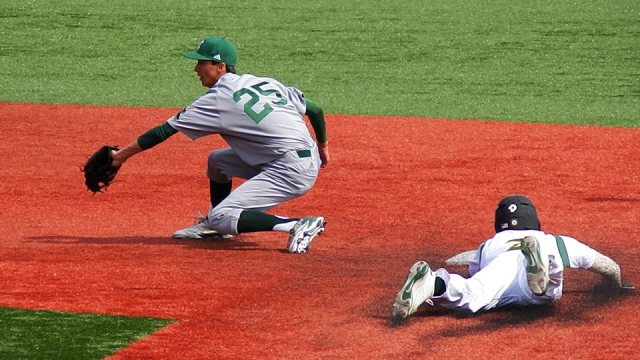
Over the past 10 summers I have had the opportunity to watch a lot of high school, summer ball and showcase games and have had many observations about stealing bases in these settings. I feel like a few simple changes, even in just how you watch the game being played that day, can really go a long way to make a player or an entire team excel.
1. You need freedom to play
I understand all games are important and we all want to win, but sometimes it is wise to make an investment for later. We do this in college during our fall season but also our first few weeks of non-conference. Make no mistake, we want to win every game we play, but we have a lot of leniency to allow our players to grow. For base stealing, this doesn’t mean we fail to teach during this time but we do allow mistakes. Actually, we do this throughout the entire year. We just try to fail less and learn to rebound after a big mistake. Typically our players understand different times to run and not to run based on what our philosophy is as a team.
- You can’t be scared to run. Typically this is from lack of confidence. I try to instill confidence in my players through education. Nobody talks more about base stealing than us. Our players understand they know more than most people when it comes to this topic, which gives them the freedom to run.
- This can also come from being dependent on a coach’s sign. All base stealers that are reading this right now know what I mean when I say it is hard to run when you are only allowed to do so with a sign. Players who are being educated through the year eventually will go during the right time but will also play fearless of being thrown out because THEY decided to go.
- Remember runners are 60% successful against Yadier Molina, one of the best in the business. Chances are, with a little knowledge, things will be fine.
2. Give yourself a better shot at success
From reading an article you can only improve a little bit but I do feel this is a key takeaway – give yourself better odds. You can do this a few ways:
- If you know nothing about stealing bases except run hard when the pitcher’s leg lifts then you still can learn to pay attention to the pitcher’s times to the plate. If you keep a stopwatch in your bag and get him warming up and you notice he is a 1.45 or over then run. I don’t care how fast you are…run. If the pitcher throws 95 mph and is a 1.45...still run. His time to the plate has nothing to do with his pitching ability. Think about it – if the catcher is a 2.2 (probably the majority of high school aged catchers in a real game) then you have to be a 3.65 to be thrown out on a perfect throw. I’m guessing most high school runners will get that easy.
- Adjust your lead according to the pitcher’s comfort level. If you have not seen a pickoff move from the pitcher through a few innings then you have to assume he doesn’t have one. Think about it – when you were little and were first able to pickoff you did it all the time…too much probably. If he has a good move he would be using it. Assume he doesn’t have a move and add to your leadoff or begin to look for patterns to run on.
- Pay attention to counts. Especially in high school/summer baseball you see pitchers who cannot simply throw fastballs by people. They tend to throw too many breaking balls, which can be very effective because it is a little different for hitters. Use this against them. So in any breaking ball count or against any breaking ball pitcher pick a count and run. Think about it – any time a pitcher is in love with his breaking ball it is because his fastball isn’t very good. Force him to go back to his fastball by being a threat to take a base. There isn’t a catcher in the country that doesn’t want fastballs called when a threat is on base.
3. Change your perspective: pickoff moves are a good thing
One of my biggest frustrations is watching a game and seeing numerous pickoff attempts to second. I rarely see a high school player with a great understanding of taking third and I will see numerous attempts with an inside move to second (I recently saw three inside move attempts versus the same runner in one at bat!). This shouldn’t deter a good base stealer from stealing a base. If the pitcher has a good move then this would change.
Remember a pitcher either has a good move or he doesn’t…picking numerous times with a bad move doesn’t somehow make it better. It increases his chances of making a mistake – either by making an error or throwing a poorly located pitch. This makes getting attention a good thing. Too often a runner gets hesitant or twitchy when he gets a few consecutive moves. Remember, you don’t need a great jump vs. a poor pitcher so stay patient.
I really feel that there are simple weaknesses to take advantage of in high school/summer baseball (even college and pro). Once players have the ability to play with freedom these holes will become evident. Good base stealing teams are able to see weaknesses immediately and take advantage of them. Great base stealing teams have the ability to run when these weaknesses aren’t nearly as obvious or can even force their own weaknesses. Give it a try and start taking calculated shots…you will be shocked at how good you are at taking a base!